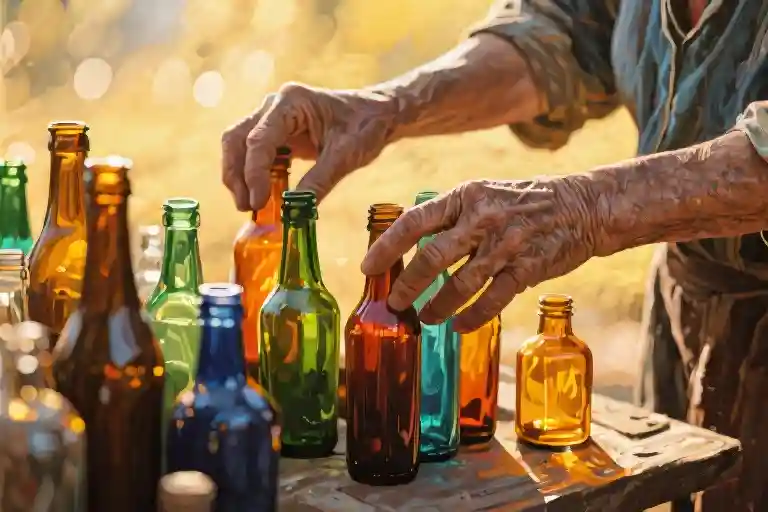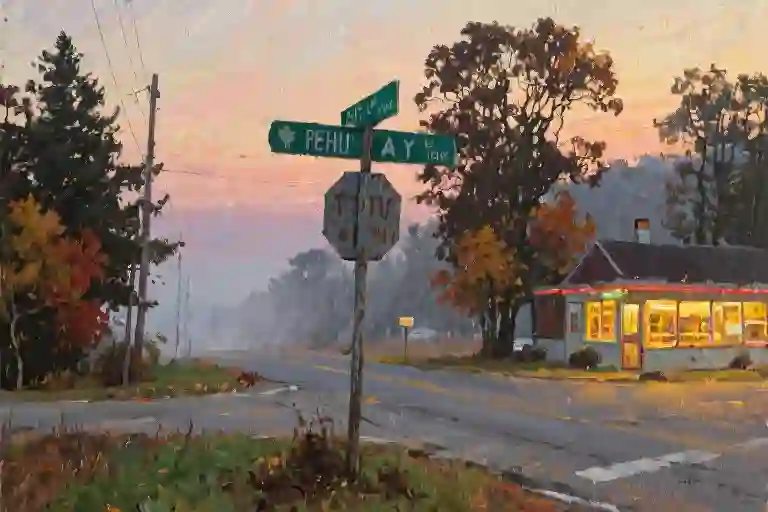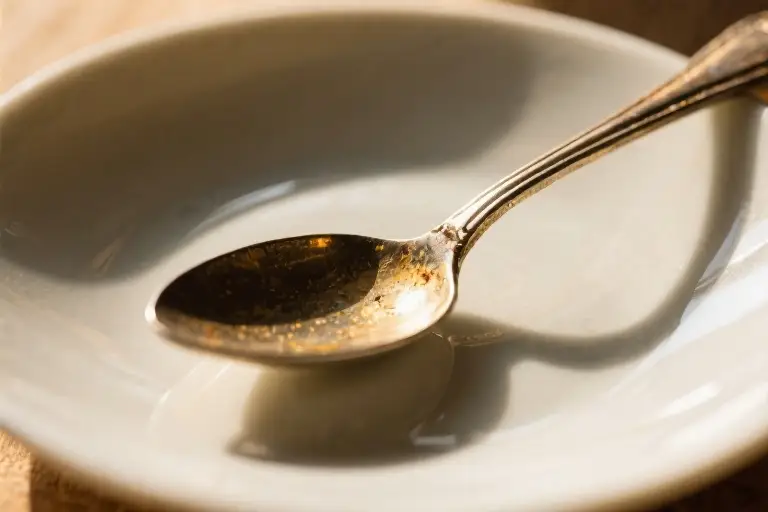The rusted soda can opener bit into her thumb again, leaving a thin red line across the calloused skin. My mother didn’t flinch as she wrapped the bleeding finger with a frayed bandaid salvaged from yesterday’s medical waste pile, its adhesive barely clinging to the metal ridges of the bottle cap she’d just unearthed. Behind the Shell gas station on Dongfeng Road, this half-acre rectangle of neglected earth – precisely 42 paces north to south, 28 east to west – had become our unlikely kingdom every Tuesday after school.
‘Mom, can these broken bottles buy me ice cream?’ I kicked at a moldy teddy bear missing an eye, watching dust rise in golden spirals through the 4:30pm sunlight. The trigonometry of our positions never varied: her bent at 45 degrees toward the ground, me leaning at 120 degrees of impatience against the chain-link fence, our shadows intersecting where discarded syringes and takeout containers formed unstable pyramids. Twenty-three years before this lot would become Harmony Community Garden with its sponsored fitness equipment, it smelled of rotting melons and diesel, of something sweet surrendering to something stronger.
What I couldn’t articulate then, what the child version of myself compressed into complaints about missed cartoon times, was the fundamental disconnect between her compulsive tidying and our actual poverty. The math didn’t compute – why collect trash when factory wages in Shenzhen (876 yuan/month according to her pay stub) theoretically bought real toys? Her hands moved with the precision of an archivist, sorting glass by color, aluminum by alloy, while I calculated opportunity costs in popsicle sticks and arcade tokens. That tension between practical survival and childhood economics would stretch across the decade like the telephone wires sagging over our makeshift landfill, humming with conversations we never quite understood.
Three blocks east, the gas station attendant Mr. Wu kept logbook entries that later revealed patterns invisible to my eight-year-old self: ‘February 3 – woman with blue scarf took 4kg paper. March 10 – left plastic bottles neatly stacked near entrance.’ His records formed accidental poetry about migrant motherhood, each dated entry a counterpoint to the letters she sent from Guangdong province, where verbs like ‘assemble’ and ‘package’ replaced the ‘gather’ and ‘mend’ of our Tuesdays. The spatial politics of this liminal zone – not quite industrial, not quite residential – mirrored our family’s own displacement, the way we occupied gaps in social structures like the weeds pushing through cracks in the parking lot asphalt.
When the streetlights flickered on, signaling our walk home past the apartment complexes whose windows glowed with television blues, I never noticed how her recycling sacks created shadows shaped like the suitcases she’d carried to Shenzhen. Only decades later would I recognize those Tuesday afternoons as our version of family dinner, the silent communion of people who love each other but speak different languages of care. The child who asked ‘why waste time?’ became the adult who saves yogurt containers, who sees in every discarded object not what it was, but what stubborn hands might make it be.
The afternoon sun slanted through the chain-link fence, casting diamond-shaped shadows across the terrain of forgotten things. I still remember how the abandoned lot behind the gas station smelled – a peculiar blend of rotting oranges, sun-baked plastic, and something metallic that made my nose wrinkle. This half-basketball court sized no-man’s-land became my mother’s unofficial territory every Tuesday afternoon when she returned from her shift at the textile factory.
The Taxonomy of Discarded Things
We could have mapped that space like naturalists documenting a new ecosystem. Nearest to the apartment buildings grew the ‘domestic layer’ – broken thermos flasks with their silver interiors glinting like fish scales, torn plush toys missing eyes, and the ever-present constellation of soy sauce bottles. Further in, the ‘industrial zone’ revealed its treasures: coiled springs from furniture, bicycle chains rusted into modern art sculptures, and the occasional mysterious metal box that fueled my childhood fantasies of buried treasure.
What fascinated me most were the time capsules – 1990s snack wrappers preserved under layers, their garish colors barely faded. A particular Pepsi can with traditional Chinese New Year designs became my temporary toy until mother gently reminded me its proper place was in her burlap sack. The medical waste (mostly empty pill bottles and the occasional syringe) formed its own disturbing cluster near the gas station’s back wall, where adults told us children never to venture.
The Tuesday Ritual
Old Mr. Chen from the gas station would nod from his perch behind the counter when we passed. “Here comes Tuesday Lady,” he’d chuckle to himself, watching my mother’s systematic patrol along the perimeter. His testimony later revealed patterns I’d been too young to notice – how she always came after the Monday trash collection, how she avoided weekends when teenagers might gather to smoke, how her route efficiently covered ground where the most recyclables accumulated.
Her hands moved with quiet precision, calloused fingers sorting materials by type and value. Aluminum cans got flattened underfoot before joining their brethren. Glass bottles were checked for chips and carefully wrapped in newspaper. The prized find was always copper wire – stripped from abandoned appliances and carefully coiled like prized spaghetti. I didn’t understand then how these classifications translated to survival, how many jin of paper equaled a school notebook, how many soda bottles bought dinner.
The Geometry of Absence
That vacant lot became my first lesson in urban space politics. The apartment dwellers treated it as extended storage, the gas station workers as a buffer zone, and the local government as invisible territory. Only my mother engaged with it as a living system, reading its layers like an archaeologist. I now recognize how these in-between spaces define Chinese urbanization – too valuable to ignore, not valuable enough to claim properly.
Her movements mapped an alternative ownership. Where others saw refuse, she saw algebra: this much recycling = bus fare to visit grandparents; that pile of scrap metal = winter coat buttons. The gas station’s fluorescent lights would flicker on as we left, our shadows long against the freshly picked-over ground. Walking home with sacks of sorted treasure, I never imagined that twenty years later I’d be explaining to my own child why we pause by the community garden to pick up a discarded water bottle, or how empty spaces fill with meaning when someone cares enough to look.
The Geometry of Spring Festival
The Physics of Three Beds
The adobe house operated on precise spatial algorithms. Grandma’s bed – the structural keystone – bore 3.5 human units nightly during holiday season. I measured weight distribution through mattress depressions: Grandma’s permanent hollow (55kg), Mom’s temporary valley (48kg), and cousin’s shallow imprint (22kg) forming an unstable triangle. The fourth occupant, winter quilts compressed to 0.3 human equivalents, completed this domestic equation.
We developed traffic protocols: 28cm clearance between bed edges required sideways shuffling, toes curling over wooden frames during midnight bathroom trips. The bedframe creaked logarithmic complaints – two groans per person-hour, escalating during humidity spikes. I charted these acoustic patterns while staring at cracks in the ceiling plaster, counting down days till Mom’s return to Shenzhen.
The Topography of Train Tickets
Mom’s Shenzhen-Hunan tickets unfolded like origami maps of our separation. Hardseat class (¥83 in 1998) tickets bore sweat-softened edges from her 14-hour journeys. I studied their crease patterns – the deep valley fold where she’d tucked it into her wallet, the diagonal tear across seat number 047 that always aligned with my birthday.
These paper rectangles held meteorological data: summer tickets warped from humidity, winter ones stiff with cold. The most precious, arriving every Spring Festival Eve, carried coal dust from train heaters and smelled of instant noodles. I stored them beneath my pillow, where they rustled like calendar pages counting our limited time together.
The Seasonal Migration of Textiles
Winter transformed our home into a fabric ecosystem. Puffy down jackets (Shenzhen factory surplus) avalanched from door hooks, wool sweaters (Grandma’s knitting) multiplied in corners, creating sedimentary layers of family history. The clothing mountain range shifted daily – Mom’s red coat advancing like desert dunes across chair backs, Grandpa’s patched overalls forming stable bedrock.
Laundry days triggered continental drift. We’d excavate lost socks (always single), flatten quilt continents for sunbathing, then reconstruct the topography before sunset. The seasonal cycle climaxed when Mom repacked her suitcase, compressing three months’ warmth into 60x40cm of polyester prison. I’d press my face against the zipper bulge, breathing in detergent and imminent absence.
The Silent Arithmetic of Goodbyes
Our holiday calculus never balanced. Three beds ÷ five adults = stolen moments whispering under quilts. 30 days × 2 hugs daily = never enough. Mom’s departure times followed factory precision – always the 6:17am bus to catch the southbound train. I’d pretend sleep while she folded ¥50 notes into my textbook (“for ice cream”), her calloused fingers lingering on the cover.
The house contracted after she left. Closet space expanded, but the silence grew denser. Grandma’s bed regained its solo depression, the ticket collection under my pillow stopped accumulating. I’d trace the phantom warmth where Mom’s suitcase had been, solving for X in the equation of next Spring Festival.
The Archaeology Beneath Our Feet
The construction crews came with their yellow excavators last spring, tearing into the earth where the old dumping ground used to be. As the teeth of their machines bit into the soil, layers of time emerged like pages from a forgotten diary. Amid the freshly turned earth, a 1998 White Rabbit candy wrapper surfaced – its waxy paper still resisting decomposition after two decades, the red-lettered logo faded but unmistakable. Nearby, half a plastic soda bottle protruded at an angle, its edges softened by time but still holding the shape of someone’s last grip.
Children from the new apartment complex gathered at the construction fence, pressing their faces against the green mesh. “Look! Dinosaur fossils!” one boy shouted, pointing at the exposed strata where rusted bottle caps lay embedded like metallic beetles. His younger sister carefully pocketed a Pepsi cap with its star logo still visible, unaware she’d just claimed a relic from my mother’s era of scavenging. The way she examined her treasure – turning it over in small hands, rubbing dirt off with her thumb – mirrored exactly how I’d once inspected the trinkets my mother brought home from the garbage field.
On the community bulletin board by the entrance, a grainy black-and-white surveillance photo showed a blurred figure bending near the gas station. The caption read “Please dispose of trash properly” but I recognized the posture immediately – that particular angle of the shoulders when reaching for something others had discarded. Twenty years hadn’t changed the fundamental geometry of need. The image quality was too poor to confirm it was her, yet I found myself visiting that notice every morning, as if waiting for the pixels to rearrange into my mother’s face.
What fascinates me now isn’t just the physical artifacts, but how space remembers. The municipal documents call this “green belt beautification,” but the land stubbornly preserves its history. When heavy rains come, the soil still yields unexpected surfacings – a shard of blue-and-white porcelain that once held my grandmother’s pickled vegetables, the twisted frame of what might have been my cousin’s first bicycle. The children have begun curating these finds along the new walking path, arranging them into patterns only they understand. Sometimes I catch them debating an item’s origin with the seriousness of museum archivists, their theories weaving between fantasy and accidental truth.
At night, when the construction lights cast long shadows across the turned earth, the terrain takes on the contours of memory. The slight depression where the old gas station’s drainage ditch ran now collects rainwater in perfect oblong shapes. The saplings planted last year lean slightly northeast, following the same wind pattern that used to carry the smell of rotting fruit across our makeshift clotheslines. Even the new benches face away from where the dumping ground’s stench used to travel – an unconscious replication of old survival strategies in modern design.
My mother never got to see this transformation. She’d laugh at the irony – all those years picking up after others, and now the city pays landscapers to artfully arrange rocks where trash once piled. But when I take my own child walking here on weekends, I notice how she pauses at certain spots, as if sensing the layers beneath her sneakers. Last week she asked why I always slow down near the third birch tree. I didn’t explain about the exact spot where my mother once found a discarded but perfectly functional alarm clock, its hands frozen at 4:30 – the time she used to wake for her factory shift in Shenzhen. Some coordinates don’t need memorial plaques to be remembered.
The county’s “Beautiful Community” initiative pamphlets show glossy renderings of what this strip will become – manicured lawns, stone pathways, ornamental lighting. What the illustrations can’t capture is how the children already interact with this space, how they’ve instinctively recognized its archaeological potential. Their games map onto old realities: the “treasure digging” zones align almost precisely with the dumping ground’s former hot spots, their little hands continuing the work of excavation my mother began. History doesn’t disappear; it just waits for the right combination of curiosity and rain.
The Algebra of Memory
Three beds multiplied by twenty years equals the exact square footage of this new community garden. The equation surfaces in my mind as I kneel on fresh sod, pressing a Band-Aid onto my daughter’s fingertip – a mirror image of that rust-cut moment decades ago when my mother’s blood first stained a soda bottle cap.
Her small hand jerks back instinctively, just as mine had. ‘Does it hurt?’ I ask, watching her examine the cartoon-printed bandage with scientific curiosity. She shakes her head, then points to the half-buried metallic glint at our feet. ‘Daddy, is that a dinosaur tooth?’ The sunlight catches the corroded edges of what was once a Pepsi bottle cap, now emerging from the soil like an archaeological artifact.
This greenbelt holds stratigraphic layers of our family history. The municipal landscaping crew, while installing irrigation pipes last spring, unearthed a 1998 strata containing candy wrappers I recognize from childhood and plastic fragments of what might have been my Transformer toy. These material memories now exist in geological time, compressed between layers of fresh topsoil and the concrete foundation of a new community center.
From our vantage point, I trace the invisible coordinates: where the gas station’s neon sign once reflected off puddles of leaked motor oil, where my mother methodically sorted glass bottles by color every Tuesday evening, where three generations learned to navigate love through crowded spaces. The spatial mathematics of memory transforms as I lift my daughter onto my shoulders – from this elevated perspective, the bottle cap becomes a pixel in the satellite image of our lives.
Later, reviewing county urban planning documents for my research, I encounter the official terminology: ‘Brownfield remediation.’ The sterile phrase belies the human calculus beneath – the unquantifiable sum of a migrant worker’s sacrifice measured in salvaged aluminum cans, the exponential growth of understanding that turns childhood shame into adult reverence. My finger pauses over the surveyor’s notation where our garbage-turned-garden sits: Lot 17, Parcel B. To the GIS mapping system, just another polygon. To us, the proving ground where my mother’s environmental consciousness took root long before ‘sustainability’ became civic policy.
At bedtime, my daughter places the cleaned bottle cap on her nightstand beside a photo of her grandmother. ‘Tell me about the magic recycling lady again,’ she requests, using the family lore title we’ve given to stories of my mother’s covert environmentalism. As I smooth her blankets – with the luxurious 60cm clearance my childhood self would have envied – the equation completes itself: The area of three beds was always the beginning, not the limit, of how much love a space can hold.




